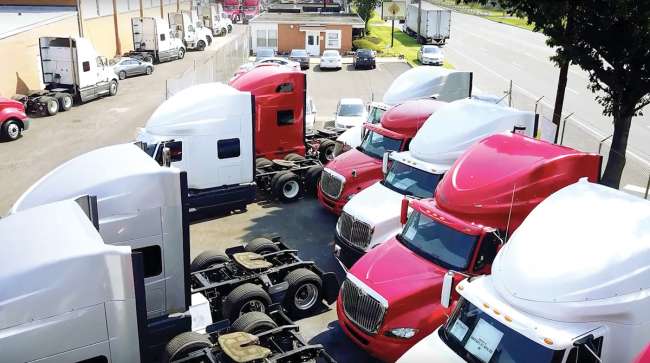Senior Reporter
Average Price for Used Class 8 Sets All-Time Record

[Stay on top of transportation news: Get TTNews in your inbox.]
The average sales price for a used Class 8 sold in April set the all-time record, clearing $57,000, 50% higher than a year earlier.
The surge came even as demand slipped compared with the month before, as is traditional, ACT Research reported.
The price climbed to $57,431 compared with $38,242 a year earlier, which was the low-water mark for 2020, according to ACT.
The previous high was $55,000, set in 2015.
It’s going to remain a very strong year for prices, experts said.

Tam
“It continues to be a very tight market, which is always an environment that carries that potential [for steeply rising prices],” said ACT Vice President Steve Tam. “If you look at some of these younger trucks that are in this data, they are doing awfully well.”
Each month, ACT surveys a sample of dealers, wholesalers and auctioneers as well as a few large fleets to determine average price, age and mileage and estimated industry sales volumes.
ACT found April sales hit 21,700, which was 26.1% higher compared with 17,200 a year earlier.
April sales also fell 9% from March’s 23,800 (a decline of 10% is typical for that interval). “As tight as inventory is, it’s admirable that the decline was only that small,” Tam said.
He added that inventory levels appear to have settled and are not getting any better or any worse as new truck buyers trade out and modernize their fleet.
U.S. Class 8 retail sales in April were 19,312, according to WardsAuto.com.
Meanwhile, the mileage on the average Class 8 dropped to 419,000 compared with 444,000 a year earlier. The age of that truck was 6 years, 4 months compared with 6 years, 9 months in the 2020 period.

Schaeffer
“No surprises there,” said Allen Schaeffer, executive director of the Diesel Technology Forum. “The pandemic influence likely trimmed back the mileage.”
With the age profile at 6 years and a few months, Schaeffer said, “these 2014 vintage trucks are all ones with the newest generation of advanced emissions control SCR selective catalytic reduction] systems, so they were designed to achieve the same emissions performance as today’s model, near-zero levels of both nitrogen oxides and particulate matter.”
Also in April, ACT reported 3-year-old trucks came down in price, but were still more than $90,000. Eight-year-olds dropped to $17,500 compared with a little more than $20,000 in March.
“Three-year-olds were 25-30% higher than 4-5 months ago, while the increase for 8-year-olds was lower, 10%-15% above the four to five month ago comparison,” Tam said.
One fleet executive found used truck pricing “astronomical” as older technology is brought back up to speed to meet the nation’s freight boom as the nation comes out of the pandemic.
“The trouble is, much older used trucks require old parts, and old parts aren’t necessarily on the counter these days, or in the manufacturing focus,” amid widespread supply chain issues, said Garrett Bowers, CEO of Bowers Trucking and Logistics Inc. in Ponca City, Okla.

When the pandemic started, drivers faced crowded parking lots, closed rest areas and minimal roadside support. And almost a year and a half later they still face the fear of not finding a place to park, which means having no place to rest. In this episode, host Michael Freeze seeks answers from those on the forefront of research and legislative action. Hear a snippet above, and get the full program by going to RoadSigns.TTNews.com.
He added: “Hauling today’s freight with yesterday’s older trucks is not going to keep you in business tomorrow. We believe that to thrive and stay on the right side of this very inflated freight market bubble, if you can’t get into the trucking business and afford a newer used or a brand new truck, you probably shouldn’t be in the trucking business.”
Bowers said his fleet typically tries to keep everything on a four-year trade cycle, and most of its re-marketing has been positioned as trade-ins for new trucks.
“However with our new lease-to-own program, we have been able to outright hand titles over to several successful drivers,” he said. “We are pretty happy about that prospect, as it not only allows us to retain drivers, but, as well, allows us to keep servicing equipment that we know and have done maintenance on for consecutive years.”
Summing it up, Chris Visser, commercial truck senior analyst at J.D. Power Valuation Services, noted trucks of all sizes and applications continue to appreciate.
“Auction pricing remains sky-high. Retail pricing is increasing,” he wrote in a blog.
Dealers are prospering.
“Looking at retail sales per dealership, our average pulled back slightly from March’s very impressive result. Dealers retailed an average of 5.6 trucks this month, 0.3 trucks lower than March,” Visser wrote. “Year-over-year, the first four months of 2021 are running a healthy 1.7 trucks ahead of the same period of 2020. It is likely these figures would be higher if dealers had a larger selection of trucks to sell.”
Want more news? Listen to today's daily briefing below or go here for more info:

